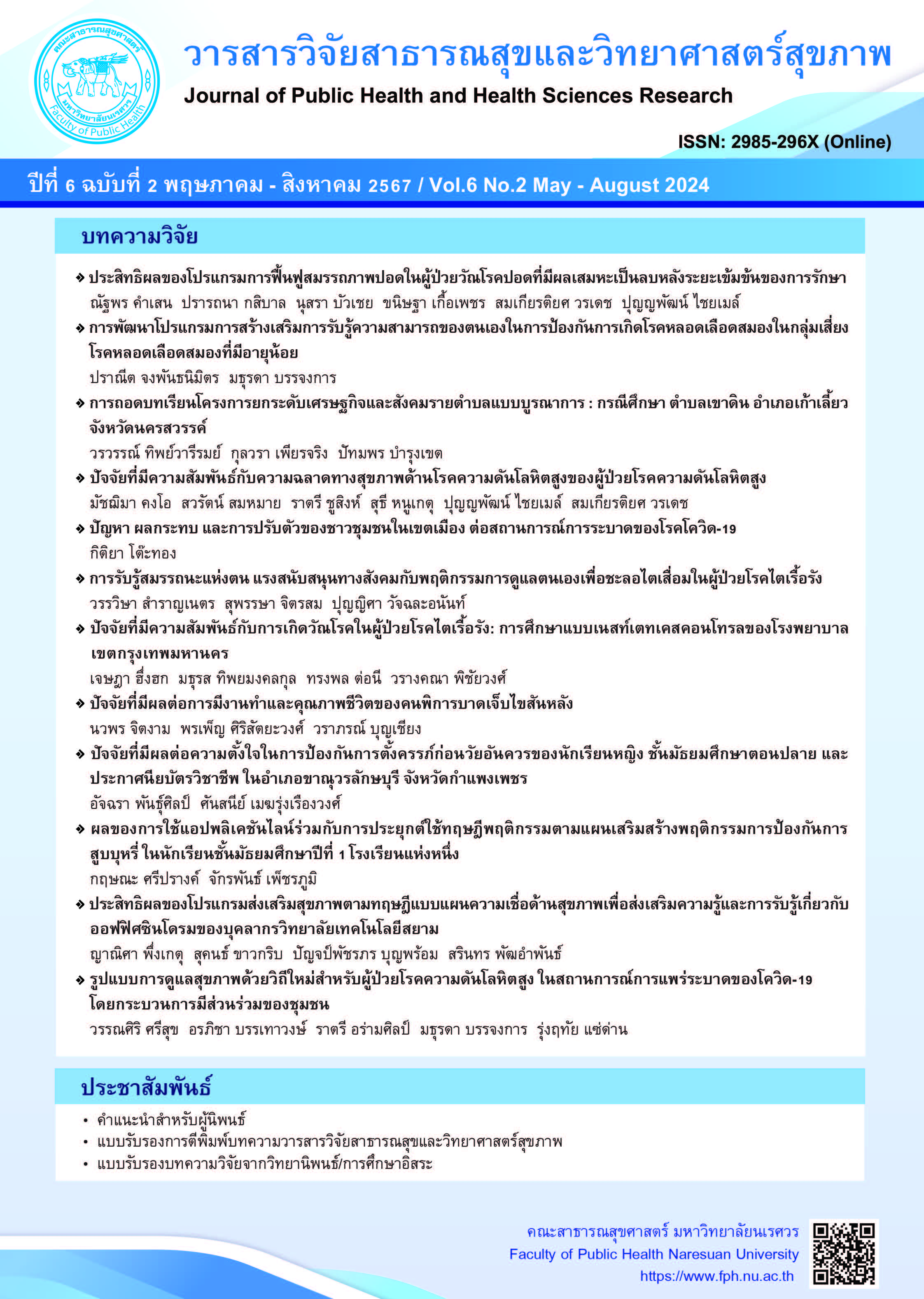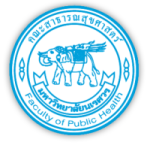The result of using application Line together with applying planned behavior theory to reinforce smoking protective behavior of grade 1 junior high school students in one school
Keywords:
Smoking prevention, Cigarette smoking, Theory of planned behaviour, Students, Line applicationAbstract
This quasi-experimental study aims to compare the mean scores of attitudes towards non-smoking behaviour, the influence of reference groups on non-smoking behaviour, perceived self-efficacy in controlling smoking behaviour, intention to not smoke, and smoking prevention behaviour, before the experiment, immediately after the experiment, and 6 weeks after the experiment. Comparisons were made both within the experimental group and between the experimental and control groups. The sample group comprised first-year high school students who were purposively selected and divided into control and experimental groups, each consisting of 59 individuals. The experimental group received the program from November 2022 to January 2023. The control group received regular teaching. Statistical analyses used included mean, percentage, standard deviation, independent t-test, and repeated measures ANOVA.
The study found that the experimental group had significantly higher mean scores for the influence of reference groups, intention, and smoking prevention behaviour immediately after the experiment and 6 weeks
later compared to the control group. There was no significant difference in the mean scores for attitudes towards non-smoking behaviour and perceived self-efficacy in controlling smoking behaviour immediately after and 6 weeks after. Regarding the mean scores 6 weeks after the experiment for perceived self-efficacy in controlling behaviour, intention, and prevention behaviour were significantly higher than the pre-experiment scores. However, the attitudes towards behaviour and the influence of reference groups showed no significant differences. Therefore, it is recommended that interested individuals can apply the program with at-risk groups or similar groups to prevent smoking behaviour in the future.
References
Ajzen, I. (2006). The theory of planned behavior. Organizational Behavior and Human Decision Processes (Vol. 50).
Antorabut, J. (2010). Effects of using a smoking prevention program in adolescents according to the planned behavior theory. Mahidol University. (in Thai)
Anapinnijnan, T., & Saengdee, Y. (2019). Communication to promote attitude, group conformity, perceived behavior control, and intention affecting the smoking cessation behavior of university students according to the theory of planned behavior. Journal of Santpol University, 5(1), 130-142. (in Thai)
Boonpen, P. (2019). Smoking behavior of electronic cigarette and smoking cessation behavior of students in Bangkok. Journal of Sri Nakarin Research and Development (Humanities and Social Sciences Branch), 11(22), 111-127. (in Thai)
Center for COVID-19 Situation Administration. (2023, December 11). COVID-19 infection situation, Ministry of Public Health. Retrieved December 11, 2023, from https://www. moicovid.com/. (in Thai)
Chaisuwan, B. (2015). New media usage behaviors of adolescents aged 10-19. Journal of Communication and Management Nida, 1(1), 31-57. form https://www.matichon.co.th/politics/news_1688649#google_vignette (in Thai)
Cholchait, W. (2020, July 10). Learning online as stress-free as possible. Retrieved July 25, 2023, from https://chulalongkornhospital.go.th/kcmh/line/เรียนออนไลน์เท่าที่ได้ (in Thai)
Klinhom, W. (2024). Strengthening Health Promotion Activities to Prevent Smoking among High School Students: Community Nurse Role. Christian University Nursing Journal, 10(2), 143-154. (in Thai)
Kuljitjaturawong, S. (2014). Line communication patterns on the creativity of Smartphone users: Advantages and limitations of the application. Journal of Administrators, 33(4), 42-54. (in Thai)
Matragoon, M. (2012). Predictive factors of smoking intention among self-smokers in Chiang Rai Province. Nursing Journal, 61(1), 10-20. (in Thai)
National Statistical Office. (2017). Smoking statistics. Retrieved September 12, 2023, from http://www.nso.go.th/sites/2014/Pages/News/2561/N31-08-61-1.aspx. (in Thai)
Nakhasombut, T. (2019). Effectiveness of Life Skills Development Program for Smoking Prevention among 5th Grade Students in Bangkok. Journal of Health Education, 42(2), 184-194. (in Thai)
Pattharasiriboon, P. (2024). Patterns of prevention and reduction of smoking behaviors among adolescents in schools with community participation: Mueang District, Chanthaburi Province. RHPC9 Journal, 18(2), 485-497. (in Thai)
Phetphum, C. (2019). Health behavior: Concepts, theories, and applications. Phitsanulok: Narasuan university publishing house. (in Thai)
Phetphum, C., Bunphoem, S., & Thawatchaijareonying, K. (2021). Comprehensive research report on the effects of communication patterns to enhance the perception of the risk of smoking and reduce smoking in the COVID-19 pandemic situation in Kosamphi Nakhon District, Kamphaeng Phet Province. (in Thai)
Phupong, S.(2022). Predictive factors for the intention to quit smoking among employees of the Bangkok Metropolitan Health Service. Nursing Science Journal of Thailand, 38(3), 63-77. (in Thai)
Polit, D. F., & Beck, C. T. (2004). Nursing research: Principles and methods. Lippincott Williams & Wilkins.
Punnakulseth, S. (2019). Factors affecting the intention to quit smoking among police officers in the Central Region, Thailand. Journal of Public Health, 28(6), 1029-1039. (in Thai)
Ratnarat, N. (2023) Community involvement strategies for smoking reduction and cessation during the COVID-19 quarantine incommunities. Journal of Arts, Rajamangala University of Technology Suvarnabhumi, 5(1), 95-109. (in Thai)
Research and Knowledge Management for Tobacco Control Center. (2017). Smoking behavior of youth in Thailand. Ministry of Public Health. (in Thai)
Ruengrungniran. (2009). Chapter 5: Toxins in cigarette smoke and their overall impact on health. Poison and Treatment of Smoking-Related Diseases. September 11, 2023, from www.ptnosmoke.com/images/pdf/download/kit-01/03/007.pdf. (in Thai)
Saraluang Pittayakom School. (2021). Annual health behavior survey report for the year 2021.
Suksukulwat, N. (2023). Prototype community for smoking reduction and cessation: Tad Kan community, Mukdahan Province. Thai Journal of Nursing, 72(1),1-9. (in Thai)
The Tobacco Atlas. (2016). Youth Smoking in Each Country. The Tobacco Atlas. Retrieved December 11, 2023, from https://tobaccoatlas.org/topic/youth.
Wisetsakorn, P. (2013). Development of a causal relationship model of smoking intention among vocational students. Thesis of Master of Science, Burapha University, Chon Buri. (in Thai)
Widick, C., Parker, C. A., & Knefelkamp, L. L. (1978). Erik Erikson and psychosocial development. New Directions for Student Services, 1978, 1-17.
World Health Organization. (2021, September 12). Tobacco kills up to half of its users. World Health Organization. Retrieved September 12, 2021, from https://www.who.int/news-room/fact-sheets/detail/tobacco
Yangpaksi, P. (2019). Predictive factors of the intention to quit smoking in non-commissioned officers in Bangkok. Nursing Journal, 68(2), 9-16. (in Thai)
Yuan, M., Cross, S. J., Loughlin, S. E., & Leslie, F. M. (2015). Nicotine and the adolescent brain. The Journal of physiology, 593(16), 3397-3412.
Zhao, J., Freeman, B., & Li, M. (2016). Can mobile phone apps influence people's health behavior change? An evidence review. Journal of Medical Internet Research, 18 (11): e287
Downloads
Published
How to Cite
Issue
Section
License
Copyright (c) 2024 Journal of Public Health and Health Sciences Research

This work is licensed under a Creative Commons Attribution-NonCommercial-NoDerivatives 4.0 International License.
The published article is copyrighted by the Journal of Public Health and Health Sciences Research.
The statements that appear in each article in this academic and research journal are the personal opinions of each author and are not related to Naresuan University and other faculty members in the university. Responsibilities regarding each article are the responsibility of each author.






